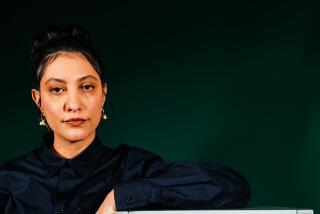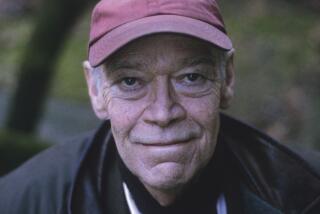Book Review : The Search for Father in His Letters
- Share via
The Letters of John Cheever; edited by Benjamin Cheever (Simon & Schuster: $19.95; 381 pages)
“My father died at about 4 p.m. in the master bedroom of his house in Ossining, New York. That was on June 18, 1982. Since then I’ve found a lot of moderately successful ways of bringing him back, of making him close and real. I wear his watch, re-read his books, speak with his friends. I read his letters.”
Benjamin Cheever has sought out and edited several hundred of John Cheever’s letters. They were written to his wife, Mary, to lovers of both sexes, to literary colleagues such as John Updike, Saul Bellow and William Maxwell, and to friends. Only a few were written to his children: Susan, Benjamin and Fred.
And yet, John’s letters and Benjamin’s commentary make a special kind of dialogue that touches and haunts, both in what is said and what is kept silent.
A son seeks, recalls and questions his father, explaining what he can. The father, his gaze fixed outward, reveals, conceals, performs and, at the best moments, exercises his art with startling directness.
Latest in Series
Cheever was the subject of a detailed but rather leaden biography published earlier this year. Several years ago, Susan Cheever wrote a painful and affecting memoir of her relationship with her father.
This new book, I think, with its two voices, gives a more vivid portrait of the writer than either of its predecessors. The facts--Cheever’s long struggle to keep afloat with his short stories, his frustrations with novel-writing, his alcoholism, his stormy marriage and his bisexuality--were already known, though in some respects, we get more detail here.
What we mostly get, though, along with some stunning bits of Cheever’s writing, is an unequaled sense of the man’s style. Grace and playfulness rode upon a deeper reserve; that reserve--except when alcohol took over--rode precariously upon a wild impulse that, even unbridled, never wandered very far from gentleness.
The wit of the letters reveals only so much; the son’s comments and questions reveal a bit more. It is as if John Cheever, with Benjamin’s hesitant but needy arm around him, were being encouraged back into a further appearance.
As a letter-writer, Cheever worked in a foundry, not a mine. He did not write in a way that discovered, or took in, new experience. He wrote to fashion what he had received. He transformed; he was not transformed.
This means that the first quarter of the correspondence, written up to the time he was in his mid-30s, tends to be jaunty and superficial, and lacking in character. Until he had the artistic maturity to shape his experience, Cheever seemed to have little interest in retailing it directly. Or perhaps he was too reserved, and needed to conceal his natural gait by dancing.
Graceful Style
His early struggles as a writer, his time in the army, his courtship of his future wife, sound like a Boy Scout writing home. Even later on, his love letters--to Hope Lange and Allan Gurganus, for instance--might almost have been written by someone sent off to love-camp.
From the late 1940s, though, the letters take on a sinew and grace that evoke Cheever’s talent at its best. Here, he describes a visit to Harper & Row, publisher of “The Wapshot Chronicle.” Cheever sees an author being led out into the reception area by an editor.
“Well thanks very much for having given us a look at it,” the editor says. “Well thanks very much for having read it so carefully,” the author replies.
“But you could tell that his heart was broken,” Cheever continues. “I went down with the author. He had on his best suit. When he slipped out onto 33rd St. you could tell that he didn’t know where to go. Authors leaving editors’ offices never know where to go. I went to 34th St. And had a drink.”
There you have 20 years of suffering--despite his success with short stories, it took Cheever that long to get a novel accepted--in one paragraph as elegant and deadly as a cageful of sunning leopards.
The letters contain some mordant literary judgments. He writes about Edmund Wilson’s “Memoirs of Hecate County,” that it is “the kind of book that is so poorly felt that you can’t look at your typewriter for a week after you’ve put it down.” Of John Updike, he writes: “I think his magnanimity specious and his work seems motivated by covetousness, exhibitionism and a stony heart.” That is devastating--whether or not there is the tiniest bit of tongue in a leathery cheek--but it is only a layer in Cheever’s literary geology. Updike became a dear friend and, toward the end, a comrade in arms. Cheever is a contrapuntalist; his contradictions are his music.
A Fine Blade
In many of his letters, Cheever uses a fanciful stoicism to suggest all kinds of real pain. A favorite tone is the Comically Aghast, as in his description of the awkwardness involved in being a tenant in a cottage on a lavish Westchester estate: “We haven’t forgotten our beginnings, and from our dining room table we look squarely into Mrs. Vanderlip’s garbage pail.”
Comically Aghast becomes an art form. A sense of dangerous chill creeps in. Here, for example, Cheever is telling of Susie, age 4. He loved her deeply, but she threatens to turn into a character.
“Susie has nothing on her mind but $30 shoes and mink coats. She has the tastes and disposition of a child’s hostess and would be as happy as a clam if she could put on a rope of false pearls each morning and spend the day leading people to their tables. . .”
It is a brilliant and funny evocation of a little girl. Still, one can see why Cheever’s children had to keep trying to disentangle his love from his art.
More to Read
Sign up for our Book Club newsletter
Get the latest news, events and more from the Los Angeles Times Book Club, and help us get L.A. reading and talking.
You may occasionally receive promotional content from the Los Angeles Times.










